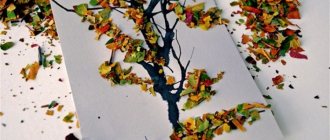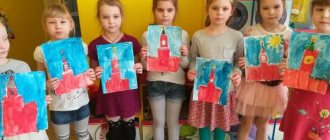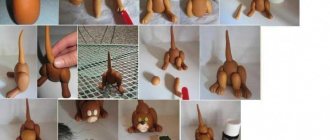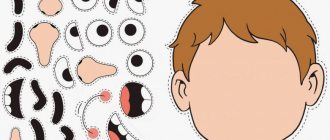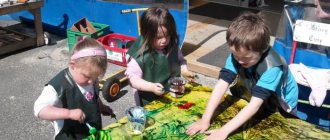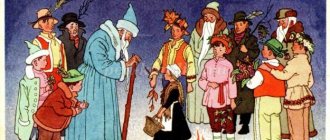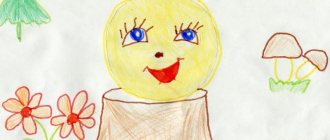On the topic: methodological developments, presentations and notes
The lesson allows you to expand and clarify children’s ideas about toys, their purpose, essential features (color, shape, size), and carry out correctional and developmental work with children aimed at n.
Our children are constantly under enormous psycho-emotional and spiritual pressure - in kindergarten, in the company of peers, while watching television. This pressure is especially noticeable for them when.
PURPOSE: 1. To introduce the concept of a table (row, column), to teach how to use the simplest tables.2. Strengthen ordinal counting within 9, ideas about the number 0, the law of conservation of quantities.
Scenario of the New Year's holiday for children of the preparatory group.
Consultation for parents.
A toy is an item intended for children's games, providing play activities for children and adults. And all the gaming equipment. The history of the toy is connected with the development of labor.
Objectives: 1. Strengthen the articulation of sounds [s-sh], exercise the ability to distinguish sounds with -sh in words, phrases and sentences. 2. Form phonemic hearing and perception. 3. Updating and replenishment of sl.
Simple applique for kids
This technique can rightfully be called a children's form of creativity. It develops motor skills, sensory perception, thinking, and imagination. Teaches you to understand shapes, colors, textures.
Promotes the development of attention, has a positive effect on the child’s perseverance and patience.
Children love bright colors, the rhythm of the arrangement of elements, and the ability to cut and connect paper figures.
Any mother can teach a lesson, so the classes help you bond with your child. Together with your baby, you can implement various ideas, stories and get a huge amount of positive emotions.
The most common figure in this type of decorative and applied art can rightfully be considered a circle.
It is thanks to the applique of circles and semicircles that both simple plots, accessible to small children, and complex three-dimensional compositions are obtained.
Summary of GCD for the application “My Favorite Toy” (preparatory group)
Yulia Barinova
Summary of GCD for the application “My Favorite Toy” (preparatory group)
Abstract of the educational activity “Artistic creativity”
( application ) “My
favorite toy ” .
Preparatory group
. Integration of areas: design , mathematics, speech development.
Topic: "My favorite toy "
Goal: development of children's creativity.
-Continue to teach children how to use scissors and stencils.
-To strengthen the ability to carefully pick up glue on a brush, spread ready-made shapes, and press parts with a napkin.
-Develop orientation on a sheet of paper.
-Cultivate accuracy when performing work.
Materials: toy car , ball, hare, tumbler, scissors, pencil, colored paper, white cardboard, glue, brushes, napkins.
MAGAZINE Preschooler.RF
Summary of a lesson on appliqué for children in the senior group Topic: “Parsley is a fun toy”Winner of the all-Russian competition “The most popular article of the month ” FEBRUARY 2018
MUNICIPAL BUDGETARY PRESCHOOL EDUCATIONAL INSTITUTION KINDERGARTEN No. 12 “SOLNYSHKO” ANAPA KRASNODAR REGION
Prepared by teacher: Valentina Nikolaevna Bulygina, 2016.
Program content:
- Learn to use appliqué to create the image of a cheerful little man - Parsley.
- Strengthen the ability to cut out symmetrical pieces of clothing from paper folded in half.
- Learn to cut out small details (buttons, circles, squares, triangles to decorate a costume).
- Know how to choose harmoniously matching colors.
- Cultivate accuracy in work.
- Cultivate friendly relationships.
Demonstration equipment: bibabo doll Parsley, appliqué samples, slide show “Petrushki” with the soundtrack of D. Kabalevsky’s play “Clowns” , recording of the song “True Friend” .
handout: A4 paper, colored paper rectangles 20☓15 cm and squares with a side of 7 cm, squares of pastel-colored paper with a side of 6 cm, strips of paper of different colors 2☓8 cm, plates for scraps of paper, pencils, felt-tip pens, glue, napkins, oilcloths.
Methodological techniques: asking riddles, demonstrating the Bibabo Parsley toy, looking at samples on the TV screen, appliqué samples, showing a child cutting, discussing the stages of making crafts, individual work during the lesson, analyzing finished works in a playful way.
Vocabulary: clown, funny, mischievous, funny, merry fellow, Parsley.
Progress of the lesson
The teacher asks a riddle about parsley:
Here is a toy - a bully, a clown, a mischief maker, a playful person! It will amuse you, make you laugh, laugh from the bottom of your heart!
The teacher shows the toy and speaks on its behalf:
- I’m a funny toy, and my name is Parsley! Look how beautiful I am! (Turns around.) What a suit I have! What a collar, and what buttons! I can sing, dance, perform magic tricks, tell riddles, listen to this:
What kind of girl is this, Not a seamstress, not a craftswoman, And she doesn’t flog or sew, But she wears needles all year round.
(Christmas tree.)
He is all made of snow, made of ice, And his beard is gray, But every year we wait for him, With him the holiday comes to our house.
He brought us all gifts. Of course it is... (Santa Claus)
Everything is fine, but I don’t have friends, no one sees my wonderful tricks, and it’s so boring to be alone.
Q: Guys, what should we do? How to help Parsley? Maybe you can give me some advice?
Children: You can make friends so that Parsley doesn’t get bored. Let them make friends, because when you have friends, there is no time to be bored.
Q: Well done, guys! I agree with you. After all, when we have a lot of friends, time flies! Friends will help you if it’s difficult for you, they will cheer you up if you feel sad!
Look at how I turned out Parsley, the artists and listen to the music “Clowns” , composed by composer D. Kabalevsky.
Q: How can we tell about Petrushka what he is like? (cheerful, happy, joyful, mischievous). I suggest you make an applique of cheerful Parsley.
- In the meantime, there is a game for you, you will like it!
Physical education minute
Parsley stood in a circle together, (imitate the actions) They will have fun playing. They took the rattles in their hands,
They began to dance merrily. (perform jumps on the spot) Ding - dong, ding - dong (nod their heads)
That's how they play. Ding - dong, ding - dong They nod their heads. They squat and stand up
(squat and stand up)
And they don’t get tired at all. And your legs get tired (sit on the floor) Let’s sit together and rest.
Let's sit for a little while.
(get up and dance)
And let's start dancing again.
Before work, discuss with the children the stages of making crafts and show them cutting by a trained child:
- Fold the rectangle lengthwise.
- Take the fold with your left hand (for right-handers) so that only the fold is on the left, and the ends of the strip are on the right. Remembering that the paper was folded in half, cut out a small neck and an arm down diagonally.
- Having stepped back a little, continue to cut straight by hand, then make a slot from below - you will get legs.
- From a pastel-colored square, cutting off the corners, we get Parsley’s head.
Q: I suggest you choose paper to depict Parsley’s suit, cap, shoes, and buttons. How do you think you can cut out a cap, buttons, decorations? (cut the square diagonally - triangles; fold the strip several times - squares; cut circles from the resulting squares.)
While the children are working independently, the song “True Friend” .
At the end of the lesson, Petrushka selects those works that depict funny, dancing Petrushkas. After this, all the children dance in a circle with Petrushka.
| Next > |
Flower applications
This craft can be presented as a gift for March 8th and birthday. Therefore, learning how to do it is extremely important.
Chamomile applique
- Number and sizes of circles per daisy:
- White 3 cm for petals – 5 pcs.
- Yellow for the middle of the flower.
- Green ones are small for the stem - in the required quantity, depending on the required length of the stem.
- Green 4 cm for leaves – 2 pcs.
Flower making process:
- We make petals by bending geometric shapes in half. Glue the petals to the base so that they converge at one point.
- Close the center with the middle of the flower.
- We form a stem.
- We create leaves from halves of figures.
Cheburashka applique
Options:
- Eight elements of the same size.
- Two elements for the eyes.
Execution of the application:
- Glue the ears to the left and right of the first sphere, and the body below. We create hands from halves of circles
- The legs are made from half circles, with the flat side down.
- Using a pencil or pen, draw the pupil, nose, and mouth.
Volume applique Fish
Options:
- Purple circle 5 cm for the muzzle.
- Multi-colored 2 cm for scales – 14 pcs.
- Purple 3 cm for the tail – 2 pcs.
- White 1 cm for the eye.
- Black for the pupil.
- Red for the mouth.
- We form a fish muzzle from a semicircle.
- Circles of different colors act as volumetric scales. Bend the spheres in half and apply glue to one half. Create the body by lightly layering circles on top of each other in the following order:
- First, second, third row of 3 elements in one row.
- Fourth, fifth row of 2 elements in 1 row.
- Sixth row – 1 element.
- The tail will be made from two halves of a circle.
We place the eyes on the head: the white and the pupil, and also install a mouth from half a round piece.
